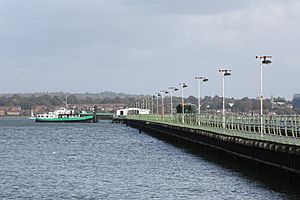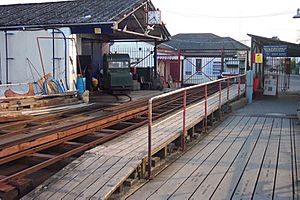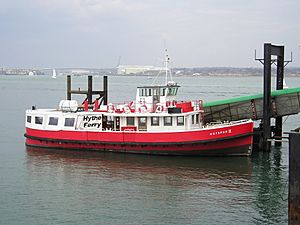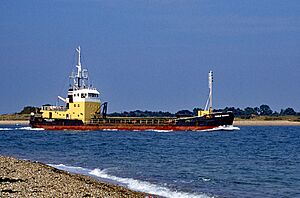Hythe Pier, Railway and Ferry facts for kids
Quick facts for kids Hythe Pier, Railway and Ferry |
|
|---|---|
 |
|
| Overview | |
| Coordinates | 50°52′29″N 1°23′37″W / 50.8746°N 1.3935°W |
| Stations | 2 |
| Service | |
| Type | Pier, railway and ferry |
| Operator(s) | Red Funnel |
| Rolling stock |
|
|
Listed Building – Grade II
|
|
| Official name | Hythe Pier |
| Designated | 17 August 2021 |
| Reference no. | 1476460 |
| Technical | |
| Track gauge | 2 ft (610 mm) |
The Hythe Pier, Hythe Pier Railway, and Hythe Ferry connect the city of Southampton with Hythe. These are on opposite sides of Southampton Water. Many people use them, from daily travelers to visitors exploring the area. They are also a key part of long walking trails like the Solent Way. The railway is super special because it's the oldest public pier train in the world that's still running! Today, Red Funnel runs the ferry. The Hythe Pier Company owns the pier and its tracks. The Hythe Pier Heritage Association takes care of the trains and carriages after they are fixed up.
Contents
Hythe Pier: A Long Walkway
Hythe Pier stretches about 700 yards (640 meters) from the center of Hythe. It reaches out to the deep water channel of Southampton Water. This makes it the 7th longest pier in the whole UK! The pier is about 16 feet (5 meters) wide. It has a path for people walking and riding bikes on one side. The Hythe Pier Railway runs along the other side. When the tide is high, the pier is about 4 feet (1.2 meters) above the water.
Building the Pier
A group of people wanted to build a pier in 1870. They got permission from Parliament in 1871. But the plan stopped there, and no pier was built.
Another company, called Hythe Pier & Hythe & Southampton Ferry Company, started in late 1874. They got a new law passed in Parliament in 1875. However, there were some legal problems with the Southampton Harbour and Pier Board. This delayed the final approval until 1878. Building the pier began in 1879. It opened on January 1, 1881, and cost £7,000 to build.
Originally, there was a small building at the start of the pier to collect tolls. This was replaced by the current ticket office in the early 1900s. The old toll house is still there and is used by a local travel company. Big repairs were done on the pier in 1896, costing £1,500.
Saving the Pier
In November 2016, a local community group held a meeting. They announced plans to "save Hythe Pier and ferry." They formed a charity called the Hythe Pier Heritage Association. In February 2017, Hampshire County Council gave emergency money to White Horse Ferries. This helped them rent a different ferry while their main one, MV Great Expectations, was being fixed.
The pier and its buildings were given a special "Grade II listed status" in August 2021. This means they are important historical buildings.
On February 6, 2019, Blue Funnel announced they would give the pier to the Hythe Pier Heritage Association. This was 140 years after the pier was first built.
On November 18, 2024, Blue Funnel confirmed they sold the pier. It was bought by a new company called The Hythe Pier Company Ltd.
Hythe Pier Railway: The World's Oldest Pier Train
The law passed in 1878 allowed for a tramway (a small railway) to be built on the pier. But it wasn't built right away. Trucks used to carry luggage along the pier were damaging the wooden floor. So, in 1909, a narrow gauge railway was built on the northern side. The tracks were flat with the pier floor. People had to push the vehicles by hand.
How the Railway Works Today
In 1922, the electric railway we see today was built. It runs on the southern side of the pier. The tracks are a "narrow gauge" of 2 feet (0.6 meters). The train gets its power from a "third rail" on the side closest to the sea. This rail carries 250 volts of direct current (DC) electricity.
The railway has only one track, so trains can't pass each other. There are two extra tracks at the land end that are not electric. One of these tracks goes into the train's covered workshop. There are stations at both ends of the line with low wooden platforms. The station at the pier head has a roof. The station on land has a ticket office and a waiting area.
The Trains
The railway uses two electric locomotives (train engines). They were built in 1917 by a company called Brush. These engines were first used at a factory during World War I. They were moved to Hythe after the war. Here, they were changed to get power from the third rail, and their batteries were removed. There was a third engine at first, but it was used for spare parts and then taken apart in 1935. Only its electric motor remains.
The railway also has four passenger coaches. Two of these coaches have a special driving area at the end closest to the sea. Usually, one train runs with an engine pushing three passenger coaches. There's also a small flat car for luggage. The engine is always at the land end of the train. The passenger coach at the sea end must have a driving area. The line also has a small oil tanker car. This is used to carry fuel to the Hythe ferries.
Hythe Ferry: Crossing Southampton Water

Every train arrival and departure at the pier head connects with a Hythe Ferry. The ferry carries people and bicycles. The trip across Southampton Water takes about 10 minutes. On the way, the ferry passes the big terminal where huge passenger liners like Queen Mary 2 and Queen Victoria dock. This gives great views of these ships when they are in port.
The Southampton ferry terminal is at Town Quay. This is also where the Red Funnel ferries to the Isle of Wight leave from. Town Quay is a short walk from the city center. You can also get there by bus from the city center and Southampton Central railway station.
History of the Ferry
Ferries have been crossing from Hythe to Southampton since the Middle Ages. A map from 1575 even shows it! Steam boats started being used in 1830. From 1889, the Percy family helped run the ferry. From 1900 to 1980, the General Estates Company, owned by the Percy family, ran the service. Because of this, many of the ferries were named Hotspur. This name came from Henry Percy, a famous person from history.
From 1991 to 2017, White Horse Ferries operated the service. Between 2017 and 2023, Blue Funnel operated the ferry. Then, it was sold to Red Funnel.
The ferry service was stopped on August 22, 2024. This was because of problems with the floating dock (pontoon) at Hythe Pier.
Collisions: Accidents at the Pier
Sometimes, accidents happen. On July 30, 1885, a sailing ship called Annie hit the pier. It damaged five of the pier's support poles. On August 26, 1915, another sailing ship, the Itchen, hit the pier, but luckily, there was no damage that time. The pier's support poles were damaged again in 1945 when a military landing craft crashed into it.
On November 1, 2003, a dredger ship called Donald Redford crashed into the pier. It tore a 150-foot (46-meter) hole right through the middle! This cut off the pier head from the land. Luckily, the dredger did not hit the pier train, and no one was hurt. This happened just minutes after a crowd of people had left after a football match. Repairs to the pier cost £308,000. The pier reopened on January 7, 2004. The captain of the dredger was sent to prison. He admitted that he was not in a fit state to operate the ship and caused damage.
On May 13, 2016, the ferry Uriah Heep collided with the pier. This damaged the ferry's control room and meant it had to stop working. A report found that the crash was almost certainly caused by a mechanical problem. The report also noted that the ferry's docking spot at Hythe didn't have much room to stop if something went wrong.







